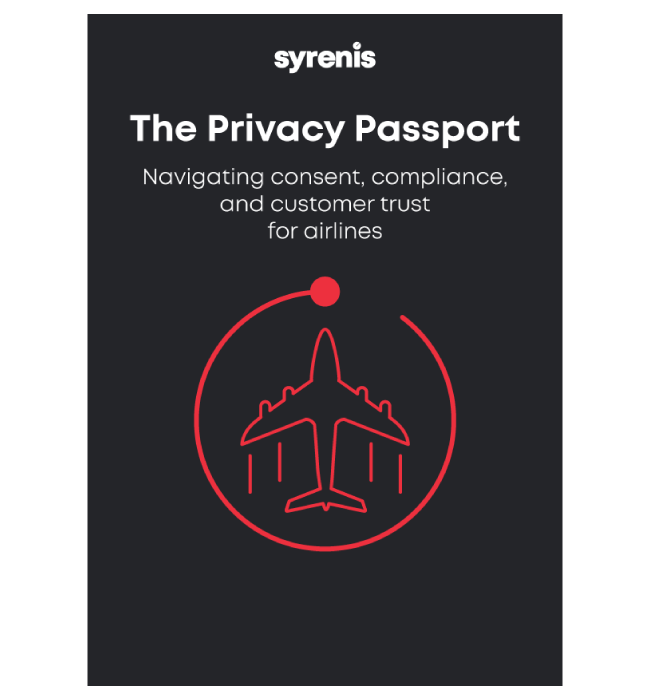The US airline industry and privacy go way back to a point before few countries had general privacy legislation. In some ways, today’s privacy concerns in the airline industry continue to ride the front end of the bell curve. This history both gives US airlines complex privacy challenges to solve and provides the experience and tools to solve those problems.
At the highest level, some of the privacy issues that the US airline industry of today must solve are:
- Data sensitivity
- Data sharing
- Global data mobility
- Customer expectations
Jump to:
- How security shaped airline data practices
- Understanding data sensitivity
- The compliance challenge for airlines
- Data sharing: The risks and responsibilities
- Global data mobility: Navigating a patchwork of privacy laws
- Customer expectations: Personalization vs privacy
- Meeting the US airline privacy challenge
How security shaped airline data practices
Two years before the security-changing event of 9/11, a bomb-wearing man in the Detroit airport attempted to board a plane. This man was stopped, but the event kicked off a flurry of security activity that resulted in airport body scanners becoming common technology. Not all members of the public reacted well to this security enhancement measure, citing privacy concerns as well as other issues.
After 9/11, of course, security measures increased exponentially, and airlines were pulled into the fray. As security protections increased, so did the amount and sensitivity of the personal data that airlines had to collect, use, and share. While passengers today are accustomed to body scanners and rarely list privacy as a concern related to airport security, there remain plenty of current US airline industry privacy issues to concern passengers, regulators, and airlines that must please both.
Understanding data sensitivity
Airlines collect two primary types of personal data from passengers. The first is Advance Passenger Information (API), which includes details from passports and other government-issued IDs, required for security and travel compliance. The second is Passenger Name Record (PNR) data, used both to meet regulatory requirements and to manage the travel experience. PNR data can include a passenger’s name, date of birth, emergency contact, travel itinerary, special service requests (such as dietary needs or wheelchair assistance), and payment information.
While payment data is widely recognized as sensitive, other elements of PNR can also raise privacy concerns. For example, a request for oxygen or mobility assistance may reveal a health condition or disability, while a kosher meal request could suggest religious beliefs. These inferences make portions of PNR data sensitive under many global privacy laws.
The compliance challenge for airlines
U.S. airlines face a complex task when it comes to handling sensitive personal data. Most global privacy laws require a higher standard of care for such data, and airlines must meet these standards, even when the data is collected out of necessity.
In many jurisdictions:
- Explicit consent is required to collect sensitive personal data.
- However, some of this data – such as health-related travel needs – is mandatory for operational or regulatory reasons, making consent difficult or impractical to obtain.
This creates a balancing act: airlines must navigate between privacy obligations and non-privacy requirements, often across multiple, sometimes conflicting, legal frameworks.
Security and safety protocols also affect employee data. Airlines increasingly use:
- Biometric systems to control access to restricted areas
- Location tracking to monitor staff movement in busy airports
- Health checks for pilots and crew, required by safety regulations
These practices involve sensitive employee data, which is also subject to global privacy laws. As a result, any discussion of airline data compliance must include employee privacy considerations.
Data sharing: The risks and responsibilities
Airlines are required to share passenger data with a wide range of entities, including:
- Government agencies
- Vendors and service providers
- Competitors and partner airlines
- Airports, travel agencies, and travel apps
Each of these parties may use the data for different purposes and follow different security and privacy practices. This creates a fragmented ecosystem where data is constantly moving, often across borders and at high volumes, introducing significant privacy and security risks.
Even though data may pass through many hands, the airline typically maintains the direct relationship with the passenger, making it the primary party responsible for protecting that data.
Different countries regulate this data sharing in different ways. For example, the EU, Brazil, and other jurisdictions impose strict rules on cross-border data transfers. These rules often require specific legal mechanisms (like Standard Contractual Clauses or adequacy decisions) to legitimize international data flows.
As a result, contracts between airlines and third parties may need to include tailored terms to meet varying legal requirements.
Moreover, front-line airline personnel often are moving targets themselves. This means that they collect, use, and share personal information through mobile devices, such as cell phones and tablets. If privacy and security are concerns on fixed devices, risks of breach, loss, and confidentiality failures are a thousand times more problematic on mobile devices. At the same time, global rules around monitoring vary and may require different notices, consents, and other restrictions.
Global data mobility: Navigating a patchwork of privacy laws
Transferring large volumes of personal data across borders is essential for airline operations, but it also introduces significant legal complexity. That’s because privacy laws differ not only by country, but also by how and where the data is collected, processed, or stored.
Here’s how different jurisdictions may apply their laws:
- By residency: Some laws (like California’s CPRA) apply to the personal data of residents, no matter where the data is processed.
- By location of processing: Others apply based on where the data is handled, such as India’s data protection law.
- By storage location: Some laws impose requirements based on where the data is hosted or stored.
Consider this scenario:
A California resident books a flight while in India to travel to France. In this case:
- California law may apply because of the passenger’s residency.
- Indian law may apply because the booking was made and processed there.
- French and EU law (GDPR) may apply once the passenger enters the EU or if the data is transferred to or from the EU.
Each of these jurisdictions has different definitions, rights, and obligations, making it difficult to determine which laws apply, and how to resolve conflicts when multiple laws overlap.
Customer expectations: Personalization vs privacy
Customers (and employees) care deeply about privacy, especially when traveling. At the same time, they expect a highly personalized, seamless experience from booking to baggage claim.
Delivering that level of service requires airlines to collect, use, and share personal data to:
- Offer tailored services
- Provide real-time updates
- Ensure smooth transitions across flights, airports, and partners
However, this creates a tension between convenience and compliance. Many global privacy laws require specific types of consent for data use, and those requirements vary widely. Some jurisdictions demand explicit consent for personalization, while others restrict when and how consent can be obtained. Definitions of valid consent and user preferences differ across regions.
This patchwork of rules makes it challenging for airlines to deliver consistent, personalized experiences while staying compliant with global privacy standards.
Meeting the US airline privacy challenge
U.S. airlines face a uniquely complex privacy landscape, marked by overlapping jurisdictions, evolving global regulations, high-volume data flows, and third-party risks. But despite these challenges, there are foundational steps that can anchor a strong, scalable privacy program.
The three most critical building blocks are:
- Identity Management
- Data Hygiene
- Consent Management
Together, these elements form the backbone of a privacy-resilient airline operation.
- Identity Management ensures that the airline knows exactly which “John Smith” is traveling to Taiwan, wants marketing emails, and lives in Tennessee. Without a clear, consistent identity across systems, both privacy and service delivery break down.
- Data Hygiene supports accurate, consistent, and interoperable data across systems. A shared data dictionary and clean, up-to-date records reduce errors, prevent privacy violations, and enable smooth data sharing across platforms and partners.
- Consent Management, built on clean data and clear identities, allows airlines to deliver the personalized experiences customers expect while meeting the diverse consent requirements of global privacy laws. A Consent and Preference Management Platform can adapt to jurisdictional differences and scale with the speed and volume of modern air travel.
By investing in these core capabilities, U.S. airlines can not only meet regulatory demands but also build lasting customer confidence in a world where data travels as fast as passengers do.

Unlock The Privacy Passport
The Privacy Passport is a strategic guide designed for airline leaders to embed privacy, consent, and trust into every layer of their operations- turning compliance into a competitive advantage.
- Unpacks global privacy regulations and aviation-specific risks
- Shows how consent and preference management fuel trust and personalization
- Offers C-suite insights and a practical checklist for privacy and AI readiness

